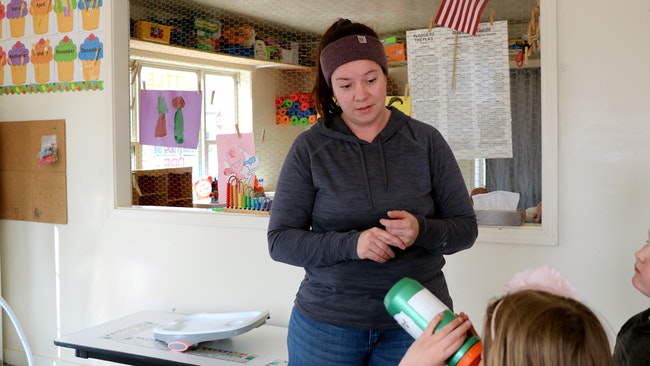
Chelsie Bates, owner of Little Hands Childcare and Preschool in Vale, said the state’s move to temporarily remove copays for families who rely on subsidies for child care is a huge relief. (The Enterprise/Yadira Lopez)
[NOTE: The Enterprise is providing free access to content concerning the pandemic. You can support this work by subscribing.]
VALE–As most students stay at home instead of heading to the classrooms, Malheur County faces a worsened child care situation.
“We don’t have enough child care before, after or during the pandemic,” said Kelly Poe, Malheur Education Service District director of early learning.
The problem is mostly lack of pay. Child care providers aren’t paid a living wage, forcing them away from the service parents need if they are going to work. A child care provider can’t do it for any long period of time and still support their family, said Poe.
A January 2019 report for Oregon State University found that only 15% of children under age 5 in Malheur County have access to a licensed child care slot, and that there is only room in those child care facilities for 413 children in the county. The county had about 2,100 children under age 5 in 2019, according to the Department of the Census.
Families need child care providers to get back to work, said Lori Clark, director of the Oregon Child Development Coalition in Malheur County.
Her facilities in Nyssa and Ontario teach the children of migrant workers, who can’t go into the fields if their children aren’t taken care of.
Clark has the option to move her class sizes from 10 children to 20 children under state guidance released Friday, but doesn’t want to increase the possibility of outbreaks which in turn would shut down a classroom.
With crop harvest beginning, the families she cares for need to go to the fields to work and know their children are safe, she said. The class limit is another precaution to make sure that happens.
Parents are either leaving one parent at home, finding other scant child care resources, having other children taking care of them, or taking them to the fields.
The program will teach about 93 children when reopening Sept. 9. It would normally teach 150.
The Malheur County Child Development program will also keep its class sizes limited at 10, said Sue Robinette, executive director. They normally have 15 children in each classroom, but “children aren’t good at social distancing, and aren’t going to social distance,” she said.
She’s not willing to take the risk of having more than 10 children until the pandemic is over, she said.
The program will only serve around 80 children now through eight preschool classrooms and two Early Head Start classrooms. That’s half of the 162 children they normally teach.
The program got a grant to increase slots to 194 students, but Robinette is not sure when they will start the extra classes, since the program might have to slip back into distance learning.
Robinette is still worried about a return to distance learning, which might happen if Malheur County slips back into baseline phase. If that happens, the program will have to go back to educational packets.
Robinette hopes to teach students who are too late for in-person spots through packets, but is concerned for parents that can’t find a child care spot anywhere.
“I really worry about the families and what they are going to do,” she said.
Chelsie Bates runs the only licensed child care in Vale, and had to tell six of her families that she can’t take care of their children again this year.
Bates normally enrolls 26 children, but due to Covid regulations can only have groups of 10. She plans on splitting them into two groups, for a total of twenty children, with only 16 taught a day so she doesn’t violate her license, and had to drop six. On her waiting list: 17 children.
She started her child care career 10 years ago, and calculated that she only makes around $4 an hour. Bates ends up working up to 16 hours a day. She has to open up her house to the state of Oregon for random inspections, pay start-up costs, and take a lot of training.
All of these burdens, she said, is why so few people want to become a child care provider and why she’s the only licensed provider in Vale.
To address the limited child care, the state should provide money to providers, said Bates. An extra $300 per month per child would make the work something that people can live off of, she said.
The parents who can’t get a slot with a child care provider will not be able to work, and will instead start to live off of state benefits, she predicted.
With school out, and some jobs lost, she estimates the amount of child care in the area has been cut by two-thirds.
The Giggles & Grace Early Learning Center in Ontario lost four of its 30 workers this summer after they closed one of their sites, said Corina Perez, education coordinator.
They are trying to hire new teachers, but the background checks are taking twice as long, and the training is difficult to deliver.
“We are just as frustrated and sad in that we can’t provide care to families that need it,” said Perez.
Giggles & Grace normally has 52 children through its preschool, toddler and infant classrooms, a number they will be able to maintain even with the decrease in workforce. They will teach 20 children in classrooms at their main-site, separated by dividers to prevent Covid spread.
The center is planning on expanding its K-5 care program to fill the care gap left by school closures, said Perez. It normally has 15 students in the program during the school year, but Perez said the wait list is “huge.”
“Some people ask, ‘If school isn’t safe, why is child care?’ Because the social and emotional development is very important for children,” said Perez.
Everyone is pleased children can come back to in-person child care, said Brevney Morales, Malheur Education Service District preschool promise coordinator.
The preschool promise program Morales oversees is open for families with income up to twice the poverty level, and she usually has a waitlist of 20 students every year.
If the county goes back to baseline phase, her preschool promise program will move back to split sessions, where groups of 10 are taught Monday Tuesday, and other groups are taught Wednesday Thursday.
Morales predicts a large increase in demand, especially from teachers who can’t watch their children and teach at the same time.
“It’s been put upon each family to figure it out,” Morales said.
News tip? Contact reporter Aidan McGloin at [email protected] or at 541-473-3377.
PRIOR COVERAGE
State temporarily makes changes to child care subsidies program
Schools required to provide child care to emergency workers during coronavirus closure
YOU CAN HELP KEEP LOCAL NEWS FLOWING: Reader support allows the Enterprise to provide in-depth, accurate reporting that otherwise would not get done. Keeping the community well informed is essential. SUBSCRIBE – $5 a month, automatically. DONATE – to provide additional support.




